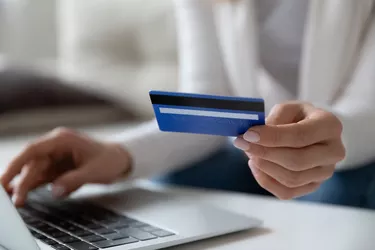
If you have multiple debit cards, there may be situations in which you wish to perform a debit card to debit card transfer. In most cases, the process is straightforward, but there can be challenges if the debit card that you want to transfer funds to is not affiliated with a brick-and-mortar bank.
Transfer Funds Electronically
Video of the Day
Many banks offer mobile apps that transfer money. Other options include the institution's website, ATM network and automated phone system. It's a good idea to familiarize yourself with the types of payment options your bank offers, including:
Video of the Day
- Transferring funds between accounts with the same financial institution: Log in to the mobile app, phone system or website and follow the instructions for transferring funds between accounts. These transfers are usually free and your funds are available immediately.
- Transferring funds between different institutions: Check the mobile app, phone system or website for your financial institution to learn how to transfer funds. In some cases, you may have the option of an instant transfer, which will be provided for a fee, or a slower, yet free, transfer that can take several days to complete.
Transfer Funds at an ATM
If the debit card to which you are trying to transfer funds is associated with a bank that has its own network of ATMs, you may be able to transfer funds using the ATM. If transferring between two accounts within the same bank, there will be a menu option at the ATM that allows you to do just that.
If you are trying to transfer funds between accounts with different banks, you'll need to visit an ATM that is owned by the bank to which you want to deposit funds and that accepts deposits. As Forbes.com notes, many ATMs do not take deposits, so you'll want to verify this before making the trip. Visit the ATM and withdraw funds from one or more debit cards. Next, use the ATM to deposit these funds into your account.
Deposit Funds at Bank
Another option is to bring both cards to a bank teller and request that the bank withdraw funds from one debit card and deposit them directly into your account with that bank. Be aware that there may be a charge for a teller visit or a fee from the other bank, and there may also be limits on the amount you can withdraw from the other account.
Deposit Funds at Retail Location
If you are unable to deposit funds to one of your debit cards at a bank or ATM, another option is to add funds or "load" the card at a retail store or check-cashing service that offers debit card loading or unloading services. Many retail grocery, convenience and big-box stores offer this service, though it is a good idea to check ahead. Freestanding check-cashing services almost always offer debit card loading and reloading options, but again, it is a good idea to call ahead.
First, withdraw cash from your debit card. You could do this at an ATM or at a check-cashing service by asking the clerk to "unload" your debit card, according to MyCurrencyExchange.com. You'll insert the card into a freestanding point of sale terminal, enter your PIN and the clerk will give you the cash you requested.
The next step is the same whether you are at a retail store or check-cashing service. Give your cash to the clerk, along with the card you want to deposit funds onto, along with your government ID (if requested). Tell the clerk that you want to deposit or load money onto the card. The clerk will add the funds and give you a receipt. It can take up to an hour for the funds to become available on your debit card.
Tip
There will be a small fee for these services and you may find yourself paying two fees at a check-cashing place: One for withdrawing money from one card and another for loading the funds onto the other. Budget for these fees when getting your cash.